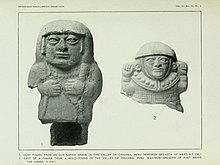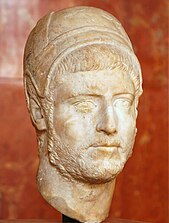
The censor was a magistrate in ancient Rome who was responsible for maintaining the census, supervising public morality, and overseeing certain aspects of the government's finances.

Jupiter, also known as Jove, is the god of the sky and thunder, and king of the gods in ancient Roman religion and mythology. Jupiter was the chief deity of Roman state religion throughout the Republican and Imperial eras, until Christianity became the dominant religion of the Empire. In Roman mythology, he negotiates with Numa Pompilius, the second king of Rome, to establish principles of Roman religion such as offering, or sacrifice.

Vesta is the virgin goddess of the hearth, home, and family in Roman religion. She was rarely depicted in human form, and was more often represented by the fire of her temple in the Forum Romanum. Entry to her temple was permitted only to her priestesses, the Vestal Virgins, who guarded particular sacred objects within, prepared flour and sacred salt for official sacrifices, and tended Vesta's sacred fire at the temple hearth. Their virginity was thought essential to Rome's survival; if found guilty of inchastity, they were buried or entombed alive. As Vesta was considered a guardian of the Roman people, her festival, the Vestalia, was regarded as one of the most important Roman holidays. During the Vestalia privileged matrons walked barefoot through the city to the temple, where they presented food-offerings. Such was Vesta's importance to Roman religion that following the rise of Christianity, hers was one of the last non-Christian cults still active, until it was forcibly disbanded by the Christian emperor Theodosius I in AD 391.

In ancient Roman religion, the god Consus was the protector of grains. He was represented by a grain seed. His altar (ara) was located at the first meta of the Circus Maximus. It was either underground, or according to other sources, covered with earth, which was swept off during the two Consualia, his festivals on August 21, December 15, and on July 7 when the pontiffs held a sacrifice there. He was thus a chthonic god.
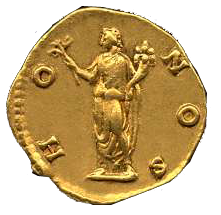
Honos or Honor was the Roman god personifying honor. He was closely associated with Virtus, the goddess of manliness, or bravery, and the two are frequently depicted together. Honos is typically shown wearing a chaplet of bay leaves, while Virtus is identified by her helmet.
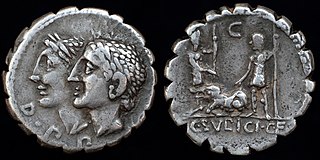
In ancient Roman religion, the Di Penates or Penates were among the dii familiares, or household deities, invoked most often in domestic rituals. When the family had a meal, they threw a bit into the fire on the hearth for the Penates. They were thus associated with Vesta, the Lares, and the Genius of the pater familias in the "little universe" of the domus.

The Aventine Hill is one of the Seven Hills on which ancient Rome was built. It belongs to Ripa, the modern twelfth rione, or ward, of Rome.

An omen is a phenomenon that is believed to foretell the future, often signifying the advent of change. It was commonly believed in ancient times, and still believed by some today, that omens bring divine messages from the gods.

Religion in ancient Rome consisted of varying imperial and provincial religious practices, which were followed both by the people of Rome as well as those who were brought under its rule.
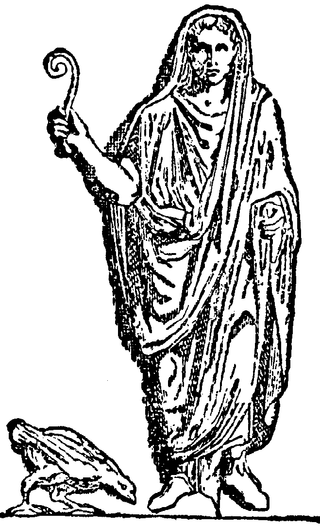
Augury is the practice from ancient Roman religion of interpreting omens from the observed behavior of birds. When the individual, known as the augur, interpreted these signs, it is referred to as "taking the auspices". "Auspices" literally means "looking at birds", and Latin auspex, another word for "augur", literally means "one who looks at birds". Depending upon the birds, the auspices from the gods could be favorable or unfavorable. Sometimes politically motivated augurs would fabricate unfavorable auspices in order to delay certain state functions, such as elections. Pliny the Elder attributes the invention of auspicy to Tiresias the seer of Thebes, the generic model of a seer in the Greco-Roman literary culture.
Caelus or Coelus was a primal god of the sky in Roman mythology and theology, iconography, and literature. The deity's name usually appears in masculine grammatical form when he is conceived of as a male generative force.

In ancient Rome, the ancilia were twelve sacred shields kept in the Temple of Mars. According to legend, one divine shield fell from heaven during the reign of Numa Pompilius, the second king of Rome. He ordered eleven copies made to confuse would-be thieves, since the original shield was regarded as one of the pignora imperii , sacred guarantors that perpetuated Rome as a sovereign entity.
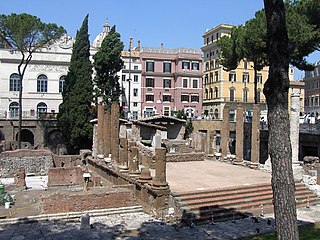
The gens Lutatia, occasionally written Luctatia, was a plebeian family of ancient Rome. The first of the gens to obtain the consulship was Gaius Lutatius Catulus in 242 BC, the final year of the First Punic War. Orosius mentions their burial place, the sepulchrum Lutatiorum, which lay beyond the Tiber.
Aetna was in Greek and Roman mythology a Sicilian nymph and, according to Alcimus, a daughter of Uranus and Gaia or of Briareus. Stephanus of Byzantium says that according to one account Aetna was a daughter of Oceanus. Simonides said that she had acted as arbitrator between Hephaestus and Demeter respecting the possession of Sicily. By Zeus or Hephaestus she became the mother of the Palici.
The gens Pinaria was one of the most ancient patrician families at Rome. According to tradition, the gens originated long before the founding of the city. The Pinarii are mentioned under the kings, and members of this gens attained the highest offices of the Roman state soon after the establishment of the Republic, beginning with Publius Pinarius Mamercinus Rufus, consul in 489 BC.
Almo was in ancient Roman religion the eponymous god of the small river Almo in the vicinity of Rome. Like Tiberinus and others, he was prayed to by the augurs of Rome. In the water of Almo the aniconic stone embodying the mother of the gods, Cybele, used to be washed. He had a naiad daughter named Larunda.

The vocabulary of ancient Roman religion was highly specialized. Its study affords important information about the religion, traditions and beliefs of the ancient Romans. This legacy is conspicuous in European cultural history in its influence on later juridical and religious vocabulary in Europe, particularly of the Christian Church. This glossary provides explanations of concepts as they were expressed in Latin pertaining to religious practices and beliefs, with links to articles on major topics such as priesthoods, forms of divination, and rituals.
The Curia Calabra was a religious station or templum used for the ritual observation of the new moon in ancient Rome. Although its exact location is unclear, it was most likely a roofless enclosure in front of an augural hut (auguraculum), on the southwest flank of the Area Capitolina, the precinct of the Temple of Capitoline Jupiter. Servius identifies the Curia Calabra with a Casa Romuli on the Capitoline, but Macrobius implies that it was adjacent to the Casa.
The auguraculum, was a roofless temple oriented to the cardinal points, in which the priests of ancient Rome practiced augury and ornithomancy. The priest observer was positioned at the center of the temple, in a tent or a hut, and watched portions of the sky from which came the birds, which were marked out by stones placed along the perimeter of the temple. From this observation, the priest was believed to be able to predict the future.
Lyco and Orphe are two sisters from Greek mythology. Their story survives in the works of Maurus Servius Honoratus, a Latin grammarian of the early fifth century AD.

